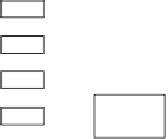Image Processing Reference
In-Depth Information
22.5.3 Field Device Tool/Device Type Manager
The FDT/DTM is a manufacturer-spanning configuration concept for fieldbus devices []. FDT is
supported by the FDT group, which consists of currently over members (vendors and users). he
FTD group is responsible for the certification of DTMs.
A DTM is executable software that acts as a device driver. An FDT/DTM configuration system
consists of the following parts: an FDT frame application for each distributed control system, a com-
munication DTM (comm-DTM) for each fieldbus system,andadeviceDTMforeachielddevice
type. Since the device functionality is fully encapsulated into the DTM, FDT/DTM does not come
with limits regarding functionality of future, eventually more complex, devices. In contrast to EDDL,
FDT/DTMcomeswithhighercostsforthedevicemanufacturerssincetheyhavetoprovidetheDTM
device drivers. On the other hand, EDDL puts greater effort onto the system manufacturers.
The FDT software has to be executed in a separate server than the basic control and database server.
Currently, DTM can only run under Microsoft Windows, which is a drawback due to Microsoft's
upgrading and licensing policies (Windows versions evolve rather fast in comparison to the lifetime
of an automation plant and it is not possible to get support and extra licenses for outdated Windows
versions).
22.5.4 Transducer Electronic Datasheet
he TEDS was developed to establish a generic electronic datasheet format as part of the smart trans-
ducer related IEEE standards family. he IEEE . [] standard specifies the TEDS including
the digital interface to access that datasheet and to read sensors or set actuators.
Figure . depicts the TEDS in context with the system architecture as defined in the IEEE
standard:
•
Smart transducer interface module (STIM): A STIM contains from to trans-
ducers of various predefined types together with their description in the form of the
corresponding TEDS.
•
Network capable application processor (NCAP): he NCAP is the interface to the overall
network. By providing an appropriate NCAP, the transducer interface is independent of
the physical fieldbus protocol.
Transducer
independent
interface (TII)
Network
Smart transducer interface
module (STIM)
XDCR
ADC
XDCR
DAC
XDCR
DI/O
Network capable
application
processor
(NCAP)
Address
logic
XDCR
?
Transducer
electronic data
sheet (TEDS)
FIGURE .
STIM connected to NCAP. (From Pitzek, S. and Elmenreich, W., Configuration and management of
fieldbus systems. In R. Zurawski, ed.,
The Industrial Communication Technology Handbook
.CRCPress,BocaRaton,
. With permission.)
















